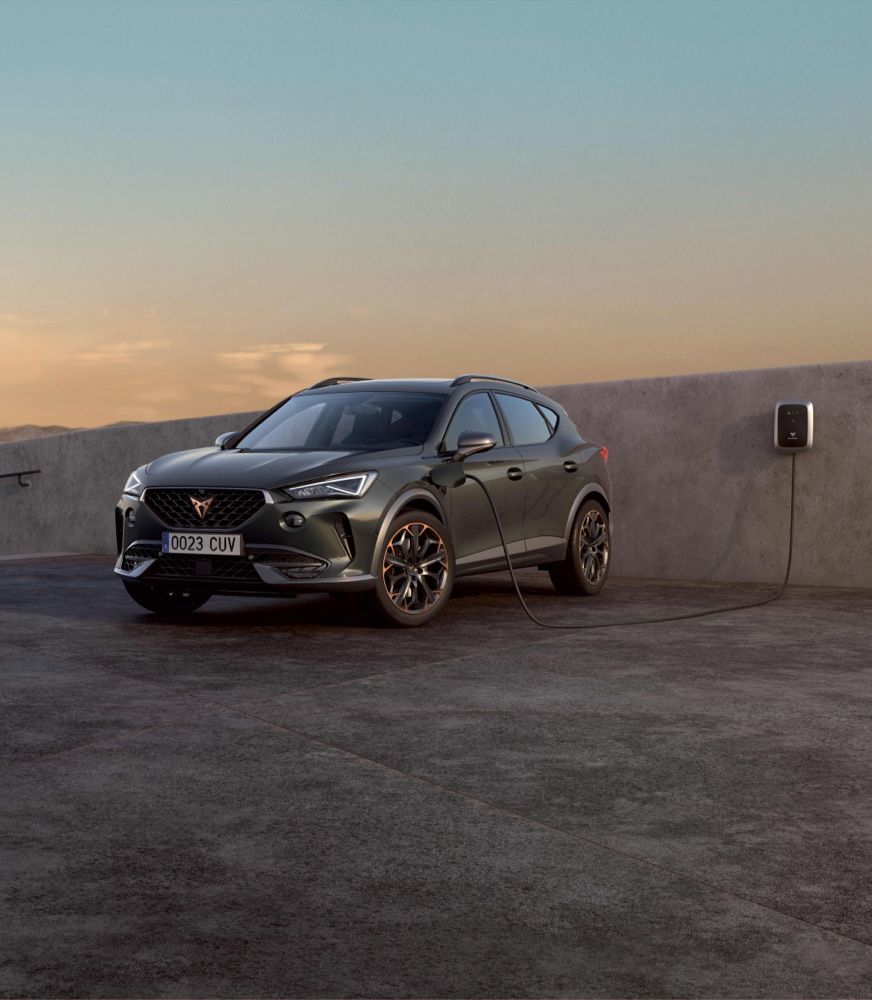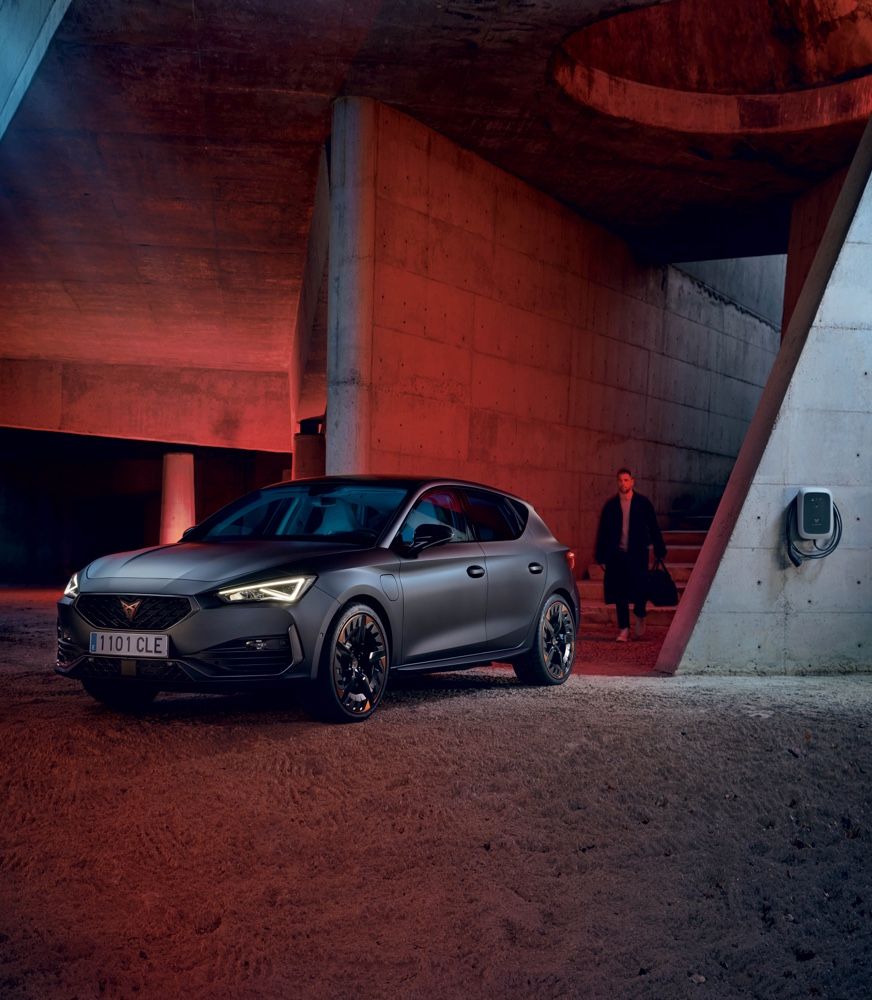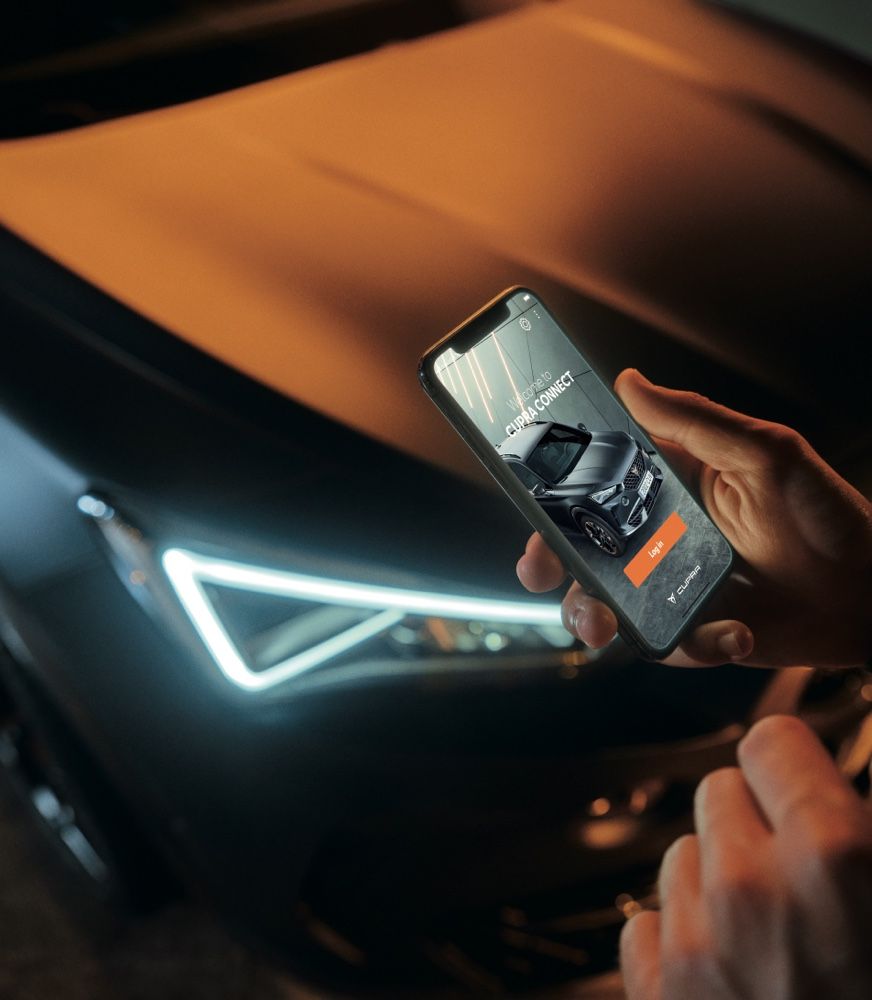
Pure innovation with CUPRA performance and electric benefits: from maximum engine torque to lower emissions.
An e-HYBRID combines an electric engine and a petrol engine, while an electric vehicle has a full electric engine and is 100% battery-powered.

The option of full-electric capacity thanks to the 10-15kWh battery. Charge at home or at a charging station for an all-electric range of 55 to 60 km or switch over to petrol for a total range of more than 245HP** until the battery is recharged again. Enjoy an all-electric engine on shorter trips and commutes and a full hybrid drive range for longer journeys.
100% electric power and zero emissions. Electric engines require no fossil fuels and are powered by one or more battery-powered engines. Charge the battery at home or by connecting at a charging station and relish in a new era of pure sustainable performance. Drive emission-free all the time with CUPRA’s upcoming 100% electric car: the CUPRA Born, which carries enough charge to cover at least 100 km in only 8 minutes.
Electric powertrains offer reduced emissions and lower costs as well as a more refined drive and responsive acceleration feel during take-off.

Self-charging electric vehicles not only save you fuel and money, but they also offer lower CO2 emissions compared to conventional engines.
Hybrid and electric cars cost less per kilometre. Gain access to discounted and free parking with lower costs on toll roads.
There are a range of incentives available for drivers making the transition to electric vehicles.
Go where you want, when you want. Almost 300 European cities have low emissions zones.
Sheer freedom to go where you wish. Discover easy charging solutions that blend seamlessly into your everyday life.

Fast, comfortable, flexible. Charge up at home or on the road using public charging stations.
It takes only 3 hours and 40 minutes for a full charge, giving you ample time to enjoy the freedom of electric mobility.
Customisable to suit every need. A choice of 3 types of charging installations means you’ll always have the ideal option tailored to you.
Have control of your battery charging status and progress and adjust your ideal temperature to start climatising your vehicle.

Seamlessly start or stop the charging process. Remain informed of the status of your charge or schedule your next charge to suit your lifestyle.
Got an e-Hybrid car already? Download the CUPRA CONNECT App and start enjoying the benefits of CONNECT.
Interested in the New CUPRA Born? Stay alert for more information soon.
- Set your vehicle ready before departure
- Manage vehicle settings
- Locate charging stations within the navigation, check power types and opening hours
- Adapt your vehicle to your needs
The e-HYBRID (PHEV) sits somewhere between combustion-engine and full-electric vehicle (EV). An e-HYBRID is capable of all-electric compulsion thanks to its battery. When fully powered up, you can drive between 25 to 70 kilometres solely on stored battery power. On short trips, the e-HYBRID operates like a fully electric vehicle (BEV) and doesn’t need to use gasoline. However, unlike a BEV, it can revert to regular hybrid operation once its electric range is depleted. Charging your e-HYBRID reduces fuel use, but it’s never mandatory.
Due to its size, a full battery charge cannot be achieved solely via the on-board generator and so requires plugging into an electrical outlet or charging station. The innovative interplay between both the electric and combustion motor allows for fuel-saving and lowers exhaust emissions while providing the user with an exceptional driving sensation.
On shorter journeys, a plug-in hybrid generally runs on pure electric power provided it makes sense, such as in urban areas. For maximum efficiency in different driving situations, such as longer journeys or when rapidly accelerating, it uses the combined power of the electric motor and combustion engine. If the battery which powers the electric motor has no charge, the vehicle will solely use the combustion engine.
Semi-hybrids, which are not charged using a power cable, use the electric motor to assist the combustion engine.
In hybrids, the electric motor and battery are larger than in semi-hybrids. Hybrids can power the vehicle using the electric motor for short distances and recharge its battery using the motor or through regenerative braking.
A plug-in hybrid can be recharged by literally plugging it into a charging point at home, or in a public one. It offers greater pure electric autonomy thanks to the larger battery and electric motor. The plug-in hybrid allows many people to make their normal commute to and from work using the emission-free, electric powered engine.
Driver’s of a plug-in hybrid benefit from an almost silent driving experience in all-electric mode, as well as additional acceleration power (torque) thanks to the electric motor.
Many plug-in hybrid vehicle owners already manage most of their journeys in electric mode as daily trips are usually well under 50 kilometres in range. Depending on your electricity tariff, considerable savings are made when compared to a vehicle with a classic combustion engine. But with a plug-in hybrid, you never have to give up complete autonomy: if the battery charge or capacity is not sufficient, the combustion engine will be automatically activated as required.
This category of vehicles also has economic advantages: through direct aid and subsidies for electric vehicles. And indirectly, with tax advantages thanks to their lower CO2 emissions.
Most users charge their vehicles at home throughout the night, with a Wallbox unit that can be installed in the carport or garage. Others are able to charge their vehicle at work or at public charging stations which are fortunately becoming easier to find.
A plug-in hybrid can be charged from an outlet, a Wallbox system or a public charging point. The maximum efficiency of a plug-in hybrid is achieved with a fully charged battery, so the possibility of charging at home or at the workplace should be taken into consideration. It is recommended that you charge your plug-in hybrid vehicle as many times as you can, so as to take full advantage of the additional electric motor.
The electric range of a plug-in hybrid vehicle depends on the size of its battery. In the case of CUPRA, the maximum electric range is between 50 and 60kms, depending on the model. The overall range when combined with the combustion engine is of course significantly higher.
Obviously, the range will depend on the model, driving style, the topography and road conditions. The main advantage of a plug-in hybrid is that you always have the gasoline engine as a reserve when between charges, so autonomy should not be a problem.
Charging times may vary, depending on factors such as the outside temperature, the current temperature of the battery, the charging equipment, the condition of the battery and the condition of the vehicle. Specific charging times are detailed in the technical specifications for each available plug-in hybrid model.
Using a standard charging cable, plug-in hybrid vehicles can be charged from a conventional 3-pin socket. For a faster charge, you can also use a charging station or a Wallbox. The CUPRA CHARGER is equipped with its own charging cable. For public charging stations, you need what is known as a “public AC charging cable” with a “Type 2” plug on both ends. In addition, a plug-in hybrid can also obtain part of its charge via regenerative power.
8 years or 160,000 km, whichever comes first.
An external factor essential to the performance and capacity of a battery is temperature. For this reason, especially in winter, it is necessary to "precondition" the vehicle during the charging process, that is, to warm up the battery and the interior. Or cool them in summer. This way you will not only save energy to use during driving, but you will also gain extra efficiency right from the start, with a battery at optimal temperature. Furthermore, optimized operating strategies in your vehicle minimize the effects of temperature as much as possible. In addition to the temperature, the range also depends on user-related factors: use of air conditioning, load weight and driving style etc.
The 5-door CUPRA Leon (180kW), The CUPRA Leon Sportstourer (180kW) and The CUPRA Formentor (150kW & 180kW) are all available with plug-in hybrid technology.